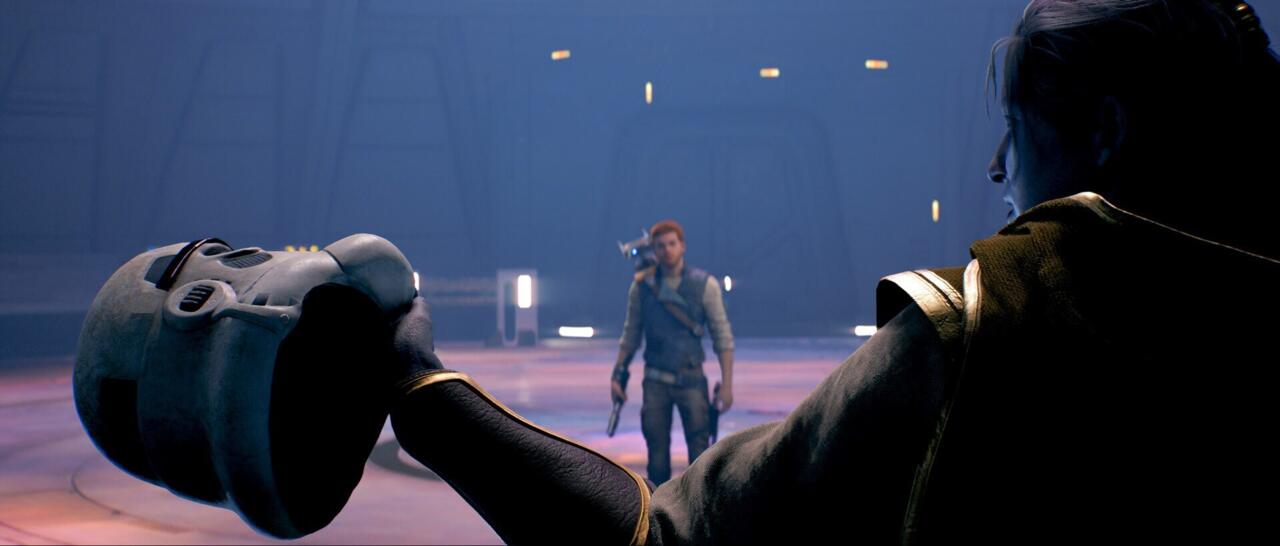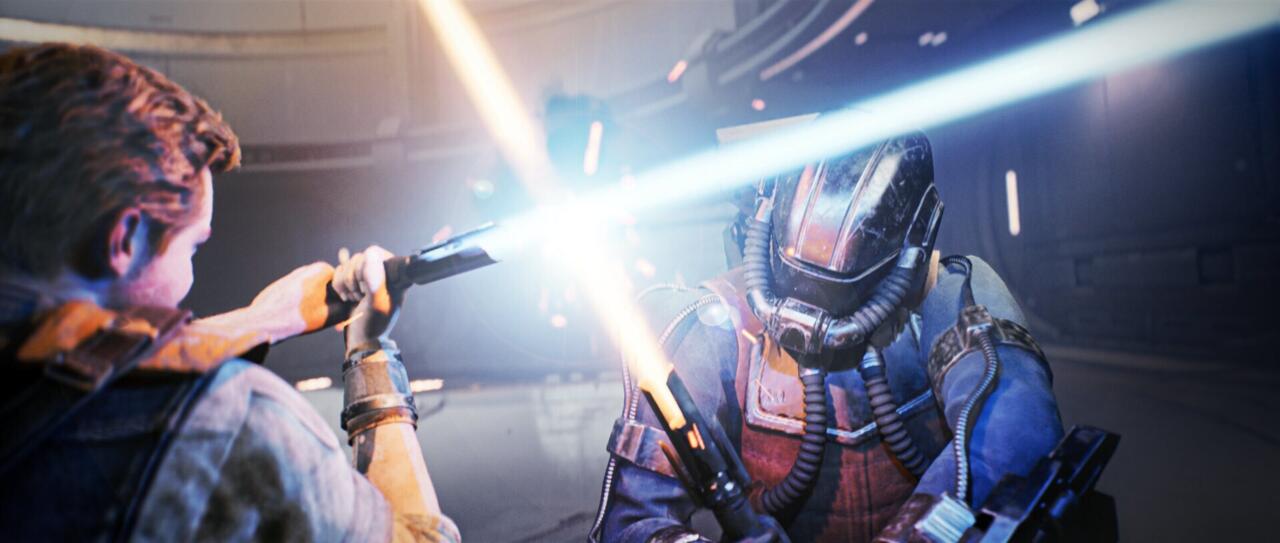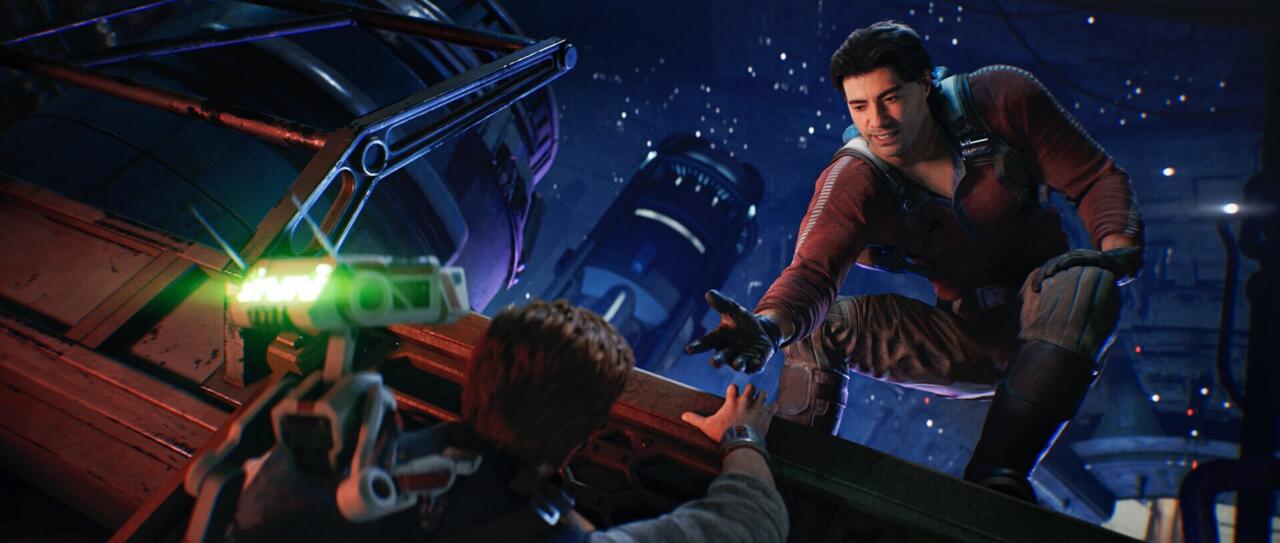Star Wars Jedi: Survivor builds on the already-winning formula of Star Wars Jedi: Fallen Order by making Cal Kestis a more powerful and resourceful Jedi Knight, while also upping the stakes and the challenges he's facing. Exhilarating lightsaber combat and physics-defying platforming puzzle challenges remain the best part of Respawn's latest Star Wars game, but Survivor also makes big swings with its story this time around. Cal's quest takes him to new corners of the galaxy, but the most compelling journey he makes is an introspective one. Survivor is a very well-written tale about overcoming fear, and it's the Jedi story I've wanted for a long time.
Survivor takes place about five years after the events of Fallen Order, with the Mantis crew having gone their separate ways to pursue different goals in a galaxy increasingly dominated by the Galactic Empire. After a daring escape from Imperial authorities, protagonist Cal finds himself on the planet Koboh, where he discovers a High Republic Jedi protocol droid who carries a clue to reaching Tanalorr, a supposedly unreachable mythical planet. Seeing a potential home that's free of the Empire's influence, Cal sets about reassembling the Mantis crew for another galactic scavenger hunt, but his efforts are waylaid by a former High Republic Jedi who--having originally discovered Tanalorr decades prior and bid his time until the right moment--wants Tanalorr for his own purposes.
The High Republic is a fascinating time period for Survivor to connect its story to given what we know has transpired between that era and the events of post-Revenge of the Sith. The comics describe The High Republic as the golden age of the Jedi. And that may be the case, but we also know this time period will culminate in the Jedi Order led by Master Yoda, who preached to a young Anakin Skywalker that "fear is the path to the Dark Side." Not anger. Not grief. Not any of the other emotions a Jedi is supposed to unhealthily suppress. The events of the High Republic teach the Jedi that fear is the path to evil--the other emotions are just stepping stones along it.
Survivor runs with that idea, exploring the concept of fear and what it means for someone like Cal, a survivor of both a war and a genocidal attack on his people, to live with the ever-present shadow of fear. As a survivor of the Jedi Order, Cal fears failing to live up to its ideals, compelling him to go to unhealthy extremes in his fight against the Empire. All the while, he pushes down the growing sentiment he feels for those he loves in order to avoid painful rejection.
While the theme of fear and how it can change you is central to Cal's journey, Survivor's main antagonists also benefit from this focus, transforming into foils for Cal to reflect on his actions. On their own, the two big bads lack the level of nuanced characterization I want from a villain--in the end, both boil down to being evil because they're selfish, albeit in different ways. It's not exactly compelling when compared to Fallen Order's terrifying and yet understandably tragic Second Sister. But as foils for Cal, Survivor's villains catalyze his growth. First, forcing him to come to terms with how his reckless pursuit of destroying the Empire and reaching Tanalorr could culminate in his own fall to the Dark Side if he's not careful. And second, recognizing the importance of being a new type of Jedi for a changed galaxy.
We've seen variations of these transformations in Jedi before--Luke Skywalker and Ahsoka Tano being the two major examples in the current canon. But in Cal's journey, Respawn delves even deeper into what it means for a Jedi grappling with the doubts and insecurities that everyday people in the Star Wars universe navigate all the time. Cal did not grow up as a normal kid like Luke nor did he have a non-traditional mentor as a padawan like Ahsoka. As a result, his attempts to wrestle with his fears of obsession and commitment are more tenuous and susceptible to outside influence than the Jedi we've seen safely balance their internal light and darkness before.

As a result, Cal's conflict with Survivor's villains sees him regularly teetering toward the Dark Side more than the typical Star Wars protagonist (save for Anakin Skywalker, obviously), leaving you guessing up until the final fight of the game as to where Cal's moral compass is eventually going to align. That seesaw ride is so poignant because Survivor's story gives Cal a lot to care about and isn't afraid to see him lose it during crucial narrative beats. The narrative incentive of Survivor isn't a desire to see the good guys win, it's to explore just how much the good guys are willing to throw away on their path to victory.
While these new personal challenges require a great deal of growth from Cal to grapple with, the more immediate physical challenges rely on a familiar set of skills and abilities. Survivor smartly avoids the pitfall of depowering its protagonist, meaning Cal starts off with the lightsaber and traversal abilities he earned during Fallen Order. Against the weaker foes of the early game, Cal already feels suitably dominant, as a seasoned Jedi that has been fighting for survival should be. You are empowered to slice through simple Storm Troopers and perform Force-propelled parkour across bottomless pits with ease. These skills don't mean Cal is all-powerful, though, and after an exciting opening chapter, Survivor puts you in your place with an assortment of challenging new enemy types. This encourages you to spend your points wisely in Survivor's branching skill tree to unlock new powers.
Much like Fallen Order, Survivor's combat primarily relies on Cal's lightsaber, slicing through an enemy's guard and parrying their strikes until their stamina gives out so you can land some solid hits. It's much easier to discern incoming attacks from fakeouts or preemptive wind-ups in Survivor compared to Fallen Order, and Cal's moves feel sharper and quicker this time around, too. This affords you more control in the heat of battle and helps the game's mostly fast-paced fights feel more surmountable. When an enemy gets a hit in, it now feels more like your mistake and not a stroke of bad luck where the glow of Cal's lightsaber and particle effects of an enemy's weapon muddied the visual language of the parry mechanic.
Cal has his own stamina meter to worry about, so combat is as much about control and careful timing as it is about being strategically aggressive. Each battle plays out as a cerebral exercise; the experience evolves with an exciting flow as you get the hang of it, all of which is captured with incredible audio detail. Each carefully deflected blaster bolt resounds with that distinctive Star Wars ping; the hum of Cal's lightsaber and the compressed flux of Force energy help sell the exhilarating thrill of playing as a Jedi Knight.

Though BD-1 is still your regular companion who keeps you healed up and unlocks doors, Cal is joined by other characters during certain parts of the story too. Either the blaster-toting Bode or magick-wielding Merrin joins Cal in certain story missions to help him deal with tougher fights. Neither one adds anything especially noteworthy to the experience of combat but they are a welcome resource for crowd control in the tough-as-nails fights in the latter half of the game, and their tag-team takedowns with Cal are all visual delights.
To go along with the idea that he's now older and more skilled, Cal also gets two new lightsaber stances in Survivor: Blaster and Crossguard. The former offers Cal a ranged fighting style while the latter deals in slow but heavy strikes. Both have their advantages, but Blaster feels a lot better in motion, matching the other three styles in sense of speed. Cal feels strongest when he's weaving through a crowd of enemies, deflecting blaster bolts and quickly striking his opponent in the moments their guard falters, and that's just trickier to do with the slower Crossguard style.
Survivor limits you to only having two lightsaber stances equipped at a time, forcing you to visit a meditation circle checkpoint in order to change them. At times, this restriction can feel frustrating as it funnels how you spend your skill points into the two styles you ultimately end up using most often, thereby discouraging experimentation. And since you only get one free skill respec per playthrough there's little opportunity to explore what could be interesting new abilities and approaches. You can respec after using the freebie, but you have to give up one of your skill points each time.
While I initially found this stifling, I came to appreciate how the limitation forced me to adapt to where I did allocate my skill points, especially when it came to lightsaber stances. Each style has its own unique strengths and weaknesses, so you can curate your own take on how Cal fights. You decide where Cal falls short--crowd control, for example, or maybe all-out attack power--and then get creative in how you overcome that weakness. I opted to focus on the jack-of-all-trades Single stance and range-focused Blaster stance, for instance, which made Cal a beast at dueling one-on-one. However, I suffered during combat encounters where the game threw a dozen enemies at a time at me. In those instances, I leaned on Force abilities to help Cal stall certain foes long enough so that I wouldn't be overwhelmed. It felt like I was able to make my own unique version of Cal who specialized in this fun hit-and-run fighting style that ultimately carried me through to the credits.
Platforming challenges and Force puzzles return in Survivor as well. Like combat, both feel better in Survivor in comparison to Fallen Order--Cal automatically latches onto climbable surfaces now, and a healthy assortment of unlockable shortcuts means that accidentally missing a jump midway through an action set piece likely won't set you back too far. Survivor has a helpful hint system, too. More importantly, it respects your intelligence, only popping up if you leave the game idling while you're in the midst of a puzzle or you seem stuck. And even then, like Fallen Order, the game will ask if you'd like a hint first instead of just giving you a clue outright--that's a welcome level of restraint. It only offered to give me hints twice, both times during puzzles I just really couldn't figure out where to go or what to do. I don't know how Survivor knew which puzzles I wanted to take the time to figure out and which I desperately needed a clue for, but it did.

Survivor is at its best when every element--story, combat, and puzzle platforming--collides together with frenetic momentum in a way that is quintessentially Star Wars. This is most apparent in one of the game's most memorable highlights, a boss fight about midway through the game. The moment features segments of combat, platforming, and a major narrative payoff, in which Cal and Merrin work together to destroy an Imperial mining tool, combining Jedi abilities and Nightsister magick in a tense, cinematic encounter where your reactions are put to the test and Survivor's absolute banger of a soundtrack is swelling in your ears. It all culminates in the two allies taking down the machine with one of the coolest finishing moves I've seen in any Star Wars project. I actually stood up from my couch and cheered when it happened--you can tell that the team behind this game understands just how cool Star Wars can be.
The game makes time for quiet moments too, best seen in another of Survivor's major new features: a hub-like area that Cal can return to frequently. On Koboh, Cal can visit a cantina that fills with NPCs you've saved on your travels across the galaxy. Some of these characters act as vendors, selling Cal cosmetics or optional gameplay perks. Others help Cal liven up the cantina with music or a rooftop garden. The best of them act as quest-givers, pointing Cal towards the puzzle boxes that are High Republic vaults, bounty hunter mini-bosses, or more recruitable NPCs. Even if the characters themselves are, for the most part, narratively flat and boring to talk to, the perks they sell are rewarding and the missions they give you are often fun to complete. Caij Vanda is my favorite--she helps you find the Haxion Brood bounty hunters who are coming for Cal after he escaped their clutches in Fallen Order. These bounty hunters are oftentimes nimble fighters with jetpacks, blasters, deployable shields, and a wide array of gadgets ideally suited for overwhelming a Force user. Tracking them down makes for some fantastically tense duels, and the rewards Caij gives Cal for doing so are some of the best in the game.
On a final note, Survivor's technical performance is a stumbling block that must be noted. Playing on Xbox Series X, I experienced random crashes on a number of occasions, all annoyingly during cutscenes before the game had a chance to autosave. On one unlucky (and deeply frustrating) occasion, the game crashed during the cutscene following an especially challenging multiple-phase boss fight that had taken me many attempts to finally beat. Because of the crash, my progress was lost and I had to fight the boss half a dozen times again, earning a victory that felt so much more hollow than the first time I beat him. On PlayStation 5, a colleague reported some occasional stuttering, screen-tearing, and crashing too, and the PC version also has a variety of technical issues relating to in-game presentation, performance, and hardware optimization.
Survivor builds on Fallen Order in several meaningful ways, tightening up the combat mechanics, expanding the variety of lightsaber styles, alleviating the frustration of platforming and puzzles, and digging into less-mainstream Star Wars lore to tell a fantastic story about a Jedi trying to defeat a tyrannical evil at all costs and coming to the realization that you can't just fight for good--you have to fight for good in the right way. It's a superb Star Wars game that gets into the nitty-gritty of the struggle of what it takes for a Jedi Knight to begin the journey toward the rank of Master.